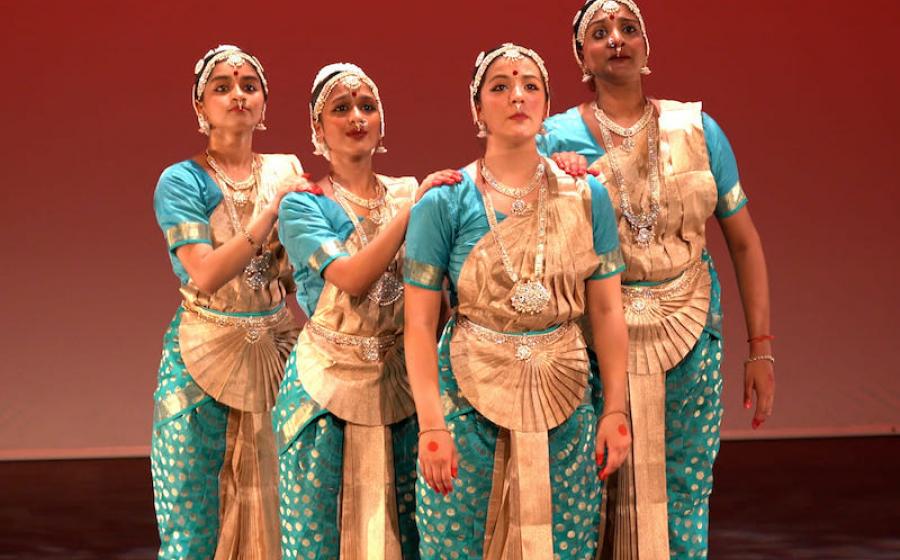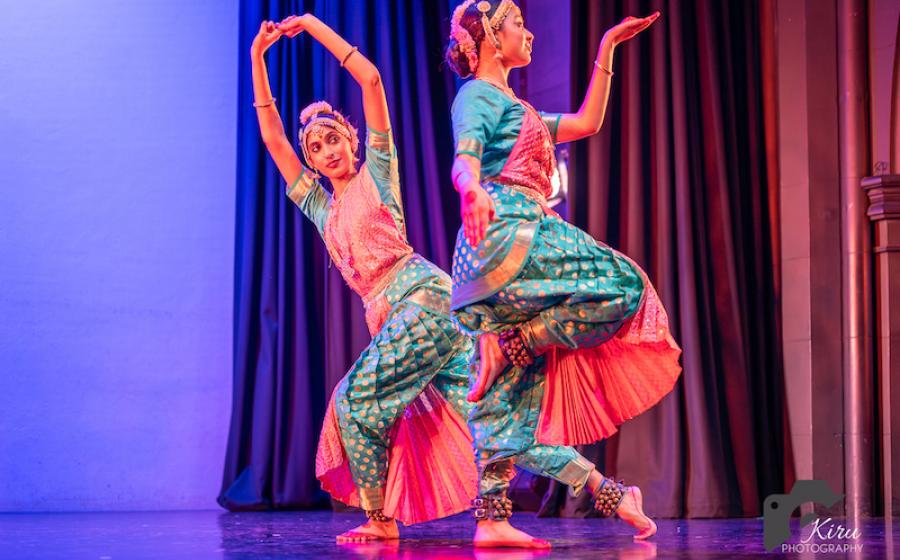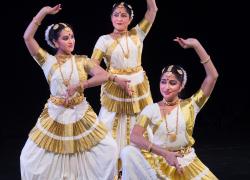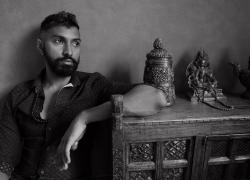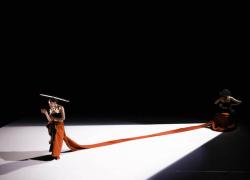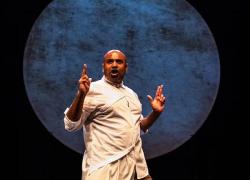Srishti Pathways
Srishti Pathways
3 March 2024
Bhavan, London
Srishti Pathways is an apprenticeship programme for students from various schools to come together under the guidance and mentorship of Nina Rajarani, CEO of Srishti Dance, for a twelve-month period. The programme concluded with a performance at the Bhavan London on 3rd March 2024. Pathways is designed to help bridge the gap between reaching proficiency and becoming a full-time dance artist and professional, a welcome initiative on the part of Nina Rajarani and Srishti dance school.
The four emerging dancers were Linea Hussman, Mitesha Mageswaran, Disha Varsani and Ritu Raj, with Varsha Vijay as an under-study. They danced in blue and gold costumes in a performance structured into four pieces. Carnatic music compositions included those of Muthuswamy Dikshitar, with new compositions set and sung by Y Yadavan. The pieces were choreographed mostly by Nina herself, with one by guest choreographer Mavin Khoo.
The evening began with a Ganesha Stuti -– ‘Ganapatim Bhaje hum’ – describing the attributes of Ganesha, choreographed by Nina Rajarani. The invocatory piece began with slow, welcoming ragas, well-coordinated movements and poses to express Ganesha’s appearance and qualities. The jugalbandi (a form of musical battle) between the two pairs was central to this with dancers inviting each other to make their ‘move’, centred around their rhythmic sensibilities. Yet, long gaps in the choreography whilst continuous sargams played in the background somehow felt disruptive to fluidity.
The second piece was a tribute to Devi, choreographed by Mavin Khoo, that added a range of choreographic possibilities and highlighted their abhinaya (expressive) and nritta (pure dance) capabilities. The directions and variations of the quadrilateral, swift movements and the use of the stage helped bring a dynamism to the group that hadn’t been so evident at the beginning. It began with a beautiful blue background and the dancers moved as though creating a big wave across the stage to a fitting raga. The blue and purple lighting further added drama. The different poses adopted including Chandi, with her tongue out, were visually arresting and elevated the stakes. This push for the group to move out of their comfort zones was discernible, and they were able to draw on their emotive toolbox. It was here for the first time that they demonstrated more trust and reliance on each other as they narrated confusion and ignorance, shown through a convoluted cluster, or a web, that the Devi eventually is meant to destroy. This felt intimate, inviting the audience to journey through their collective connections and bewilderment on stage. However, also noticeable were the stark differences in facial expressions and abhinaya within the group, which are largely meant to be in sync.
The third piece, ‘Ragam Tanam Pallavi’ (RTP), is primarily performed at a Carnatic music concert, to which the choreographer and dancers have attempted a bharatanatyam configuration. The Ragam part of RTP began with a slow mood as though imitating the evening sun, merging into the melodic symphony of the Tanam executed through a combination of eye movements and adavus. The Pallavi and the last piece of the evening – Thillana – tested the dancers’ capacity for tala, jatis, and rhythmic dexterity. The audience weren’t disappointed. The collaborative entry and exits of dancers through the combination of different jatis retained the soul of what the Thillana is meant to be – fun, celebratory and rhythmically enchanting.
Overall, it was a captivating performance for the audience, evident from the admiration, and whistles the performance received. The angular coordination, symmetry, clear lines, and the synchronised footwork were impressive. The attention to rhythm as a group is noteworthy. However, there are some areas for consideration. Whilst the dancers are skilful in the nritta component and execution of symmetrical positions, the overall mood and abhinaya aspects lacked variation and nuance, visible to a certain extent in the Devi piece. The group could further build on their chemistry, eye contact, interactions and facial expressions to build a story together, as well as technique. Having said that, a programme like this is a culmination of passion, dedication, hard work, a first of many steps in the right direction.
Pranita Choudry is a UK-based bharatanatyam dancer and social science researcher in the International Development sector working with charities and not-for-profit organisations.

